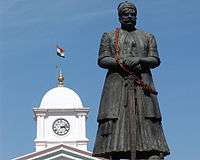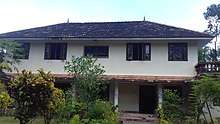Velu Thampi Dalawa
Velayudhan Chempakaraman Thampi (1765–1809) was the Dalawa or Prime Minister of the Indian kingdom of Travancore between 1802 and 1809 during the reign of Bala Rama Varma Kulasekhara Perumal. He is best known for being one of the earliest individuals to rebel against the British East India Company's supremacy in India.
Early life
| Part of a series on the |
| History of Kerala |
|---|
 |
|
Main Megalithic culture Maritime contacts |
|
Other topics |
|
Velayudhan Thampi was the son of Sri Kunjumayiti Pillai and his wife Valliyammai Pillai Thankachi from the Nair caste. He was born on 6 May 1765 in the village of Thalakulam, the present day Kanyakumari district of Tamilnadu state then a southern district of Travancore State. His house name is Valiyaveedu. He came from a family that held the high title of Chempakaraman for their services to the state by Maharajah Marthanda Varma. His full name was "Idaprabu Kulottunga Kathirkulathu Mulappada Arasarana Irayanda Thalakulathu Valiya Veettil Thampi Chempakaraman Velayudhan. Velu Thampi, was appointed a Kariakkar or Tahsildar at Mavelikkara during the initial years of the reign of Maharajah Dharmaraja Ramavarma.[1][2][3]
Rise to Dalawaship
Bala Rama Varma was one of Travancore's least popular sovereigns whose reign was marked by unrest and various internal and external political problems.[4] He became rajah at the age of sixteen and fell under the influence of the corrupt nobleman Jayanthan Sankaran Nampoothiri from the Zamorin of Calicut's kingdom. One of the first atrocities of his reign was the murder of Raja Kesavadas,[5] the then Dewan of Travancore. Sankaran Nampoothiri was subsequently appointed Dewan or Prime Minister assisted by two other ministers. The state treasury was soon empty due to corruption so it was decided to collect money by ordering the tahsildars (district officers) to pay large amounts of money which were determined without any reference to the revenue of the districts. Velu Thampi, the Tahasildar(Karyakar) of a southern district, was ordered to pay Rs. 3000 to which he responded that he needed three days to pay. Velu Thampi returned to his district, gathered the people and an uprising ensued. People from all parts of Travancore united to surround the palace and demand the immediate dismissal and banishment of Jayanthan Sankaran Nampoothiri. They also demanded that his two ministers (Matthoo Tharakan,Sankaranarayanan chetty) be brought to a public place then undergo flogging and have their ears cut off. The punishments were duly carried out and the two ministers were put in jail at Trivandrum. Velu Thampi was later appointed the Dalawa of Travancore.[6]
Career as Dalawa

After Velu Thampi became Dalawa of Travancore he faced serious opposition from two relatives of the late Raja Kesavadas who sought assistance to get rid of him from their associates in Bombay. These letters were intercepted and presented to the Maharajah in a negative light and he ordered the immediate execution of the two men, Chempakaraman Kumaran Pillai and Erayiman Pillai. Having cleared the way, Velu Thampi became Dalawa with no opposition. The Madras Government sanctioned his appointment within a few months.
Velu Thampi was not an able statesman like Ramayyan Dalawa or Raja Kesavadas, his immediate two predecessors. He was of rebellious nature. Within three years of the death of Raja Kesavadas the country was plagued with corruption and various problems caused by the banished Namboodiri Dalawa. Velu Thampi resorted to harsh punishments with a view to improve the situation. Flogging, cutting off of ears and noses as well as nailing people to trees were some of the punishments adopted during his term as Dalawa. Nevertheless, his harsh measures produced results and peace and order were restored within a year of Velu Thampi's accession to the Dalawaship.
Intrigues
The Dalawa's undue severity and overbearing conduct resulted in resentment amongst his colleagues, the very same people who had assisted his rise to power. A conspiracy was formed against him under the influence of Kunjunilam Pillai, a powerful Travancore cabinet official who succeeded in getting the Maharajah to sign a royal warrant to arrest and immediately execute Velu Thampi Dalawa. The Dalawa was at Allepey when he received news of the conspiracy and immediately hurried to Cochin to meet the British Resident, Major Macaulay, who had become a good friend. Macaulay had already received evidence that Kunjunilam Pillai had a major hand in the murder of Raja Kesavadas and hence he armed Velu Thampi with a small force of British soldiers and sent him to Trivandrum to investigate Kunjunilam Pillai's conspiracy. Pillai was found guilty of murder and conspiracy and punished accordingly. With this obstacle removed, Velu Thampi regained his former influence.
Mutiny of the Nair troops
The armies of Travancore consisted mainly of members of the Nair group of castes. Velu Thampi's 1804 proposal to reduce their allowances was met with immediate discontent. The troops believed that the idea had come from the British and immediately resolved to assassinate both Major Macaulay and Velu Thampi. Velu Thampi fled once more to Cochin to seek refuge with Macaulay. The Nairs marched to Trivandrum with a ten thousand strong army of sepoys and demanded that the Maharajah immediately dismiss the Dalawa and end any alliance with the British. Meanwhile, the Resident and the Dalawa collected forces at Cochin and, assisted by the Carnatic Brigade, marched to Trivandrum and put an end to the mutiny. Several of its leaders were executed in the most gruesome manner. One Krishna Pillai, a commander of a regiment, had his legs tied to two elephants which were driven in the opposite direction, tearing him to pieces.
Alliance with the British
The Treaty signed with the British East India Company by the popular Maharajah Dharma Raja Rama Varma in 1795 was revised in what is known as the Treaty of 1805 (according to the English East India Company's policy of "Subordinate Isolation") after the insurrection of the Nair troops in Travancore. It increased the British Indian force stationed in Travancore and the amount of money to be paid as tribute to the British, though the expenditure of the State in maintaining its own standing army was drastically cut. This was the main change brought about in the Treaty of 1805.
Position
Travancore was at that time, owing to all its internal problems, facing a heavy financial crisis and the ratification of the Treaty by Velu Thampi created serious discontent as it increased the dependence of Travancore on the British and also made it indebted to the English Company. In spite of being fully aware of the financial crisis in Travancore, the Resident Major Macaulay pressed Velu Thampi for immediate payment of the large amount of tribute and the expenses of putting down the mutiny of the Nair troops. The Maharajah meanwhile wrote to the Madras government for the recall of the Resident and appointment of a new Resident which was denied. But this news made the Resident more obstinate against Travancore and he pressurised the Dalawa for payments immediately.
The Dalawa was now disillusioned with the British whom he had considered a friend and who considered any "aggression on Travancore as an aggression on themselves" as per the previous treaties. His discontent was first given vent to by the assassination of the ambassador of the Resident in the court. The Maharajah had communicated his discontent with the Dalawa to this ambassador, a certain Subba Iyen, and this information was known to the Maharajahs wife, Arumana Amma, a noblewomen of the Arumana Ammaveedu family. She was a lady of influence, who apparently communicated Royal secrets to the Dalawa, and she informed the Dalawa of the Maharajah's intention to dismiss him, with support from the Resident. This increased the anger of the Dalawa against the British. First the Resident demanded for impossible amounts of money and now he had started interfering with the internal affairs of the state.
Insurrection

Velu Thampi Dalawa and the Paliath Achan, Govindan Menon, met and decided on the extirpation of the British Resident and end of British supremacy in their respective states. Velu Thampi organised recruits, strengthened forts and stored up ammunition while similar preparations was made by the Paliath Achan in Cochin. Velu Thampi appealed to the Zamorin of Calicut and to the French for assistance, but both did not acknowledge the request. The plan of the Paliath Achan and Velu Thampi was to unitedly attack the Fort of Cochin and murder the British Resident Major Macaulay and Kunju Krishna Menon. Another force was appointed to attack the British garrison at Quilon. This was in 1807 and is known as Battle of Quilon.[7]
In the aftermath of the battle, Velu Thampi fled from Trivandrum and committed suicide in the Mannadi Temple.
The Government of Kerala instituted a memorial to Dalawa, a research centre, a museum, a park and a statue at Mannadi near Adoor. Another statue of Velu Thampi Dalawa can be found in front of the Secretariat of Kerala in Trivandrum.
Honours

The sword that was used by Velu Thampi Dalawa to fight against British imperialism, was kept with the Kilimanoor royal family, for about 150 years. It was presented in 1957, to India's then president Rajendra Prasad by a member of the royal family. On 20 June 2010 it was brought back to Kerala and was placed in the Napier Museum (Art Museum)Thiruvananthapuram, Kerala.[8]
A commemorative postage stamp on him was issued on 6 May 2010.[9]
Notes
- Sobhanan, B. (27 April 1978). "Dewan Velu Tampi and the British". Kerala Historical Society – via Google Books.
- Rajeev, Sharat Sunder (6 May 2016). "Home of the brave" – via www.thehindu.com.
- "A real to reel story of a warrior". The New Indian Express.
- "TRAVANCORE UNDER BRITISH RULE" (PDF). shodhganga.inflibnet.ac.in.
- P. Shungunny Menon. History of Travancore. Page 245.
- P. Shungunny Menon. Thiruvithancore Charitram. (History of Travancore). Page 245-251.
- "A place in history". 30 June 2006 – via www.thehindu.com.
- http://www.hindu.com/2010/06/21/stories/2010062160660300.htm.
- "Stamps - 2010". Department of Posts, Indian government. Retrieved 2 August 2013.
External links
| Wikimedia Commons has media related to Velu Thampi Dalawa. |